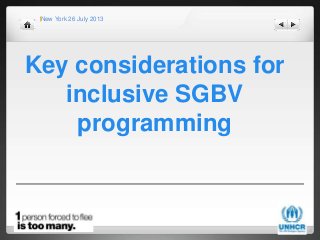
Programming gaps in male directed sexual violence
- 1. New York 26 July 2013 Key considerations for inclusive SGBV programming
- 2. Session Presentation programming gaps Survivor’s experiences – gaps and interventions Way forward – group work
- 3. Understanding the needs of men and boys Medical treatment Mental health Social health Legal protection Livelihood support
- 4. Train all staff in inclusive understanding of SGBV Examine assumptions and stereotypes of staff Develop strategic partnerships with organization that have relevant expertise Provide training on protection issues, essential services and counseling
- 5. Community awareness Conduct information sessions with community groups – potential victims include men and boys Inform women, girls, men and boys about the available services
- 6. Work with individuals Be alert to indicators for identification Pay attention to signs and respond to them Provide information about available services, confidentially and sensitively Let the survivor choose the interviewer: man/woman (and interpreter) Respect the survivor’s narrative and do not try to redefine his experience Extend individual counseling to include support persons such as spouses and other family members
- 7. Work with individuals Acknowledge the legitimacy of feelings of anger Clarify for survivors that coerced sexual acts are not necessarily linked to sexual orientation
- 8. Provide peer survivor support Provide a safe space in which groups can form and meet Encourage self-help activities
